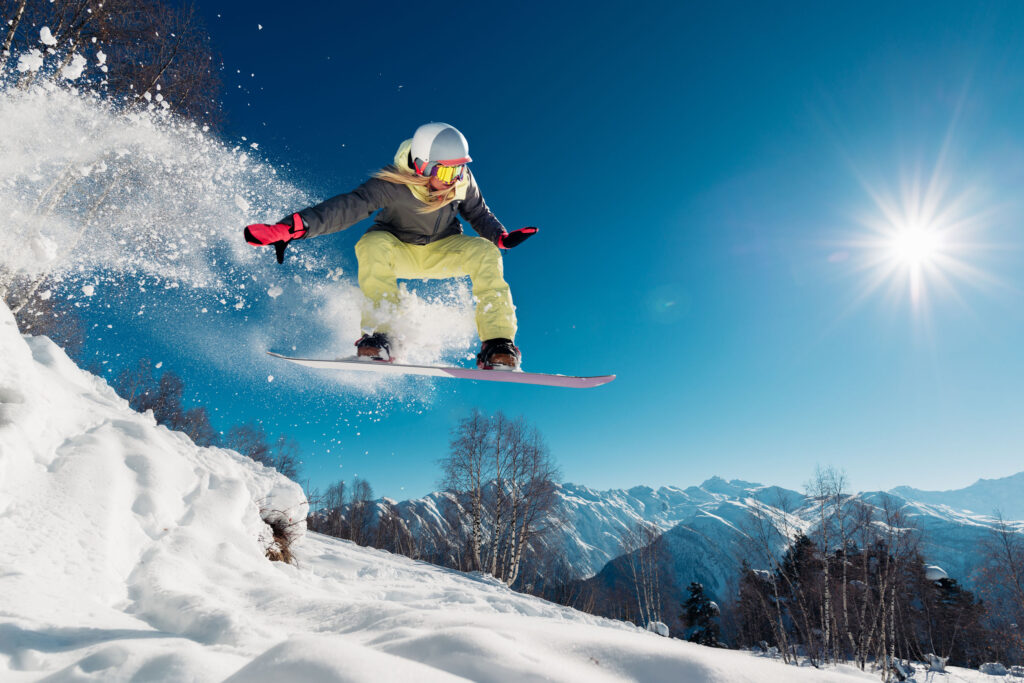
Are your family and friends fighting an annual bout of cabin fever? Sounds like you need to get out and enjoy the great outdoors. Thankfully, there are a number of exciting Chicago winter sports for you to enjoy.
There are a few measures you can take to be sure that your winter remains a wonderland. First, check out these awesome places to get your ski, board, or sled on. Then, learn about the safety precautions you should take. Ensure a fun winter by traveling safely to your sports destinations. Finally, in case of an injury caused by another, give the Chicago injury lawyers at Lerner and Rowe Injury Attorneys a call.
Chicago Winter Sports Wonderlands
Even though winter weather conditions may make it cold and slick outdoors, you may eventually feel the itch to get out of the house. So naturally, you’ll want to plan the perfect activity. That is why we compiled a list of the best places for winter activities and getaways near Chicago. These winter wonderlands are a great place to start.
Where to Ski or Snowboard Near Chicago
Skiing and snowboarding are two of the most common Chicago winter sports. Thankfully, anyone living in or near Chicago lives within driving distance of many slope destinations.
Villa Olivia is the closest choice for Chicagoans. Villa Olivia has an easy quarter-mile run for those who want a quick ski, board, and sled fix.
Two other great destinations can be found in nearby Wisconsin have a little more to offer—Devil’s Head Resort and Wilmot Mountain. You’ll have a blast on Devil’s Head’s 30 hills. Wilmot Mountain’s Snocross course brings even more extreme fun.
Where to Cross-Country Ski in Chicago
Not looking for so much downhill? Check out these locations for cross-country skiing, much closer to downtown.
- Camp Sagawau
- Lincoln Park
- Morton Arboretum
- Northerly Island
If you don’t own your own gear, you can easily rent some. Rental shops are fairly common. You may even be able to find rental deals for the season on popular coupon apps. Also, explore state forest preserves and parks.
What Are the Best Ice-Skating Rinks in Chicago?
Skating more your style? In a big city like Chicago, don’t be surprised if a rink seems to pop up in almost any park you find. The McCormick Tribune Ice Rink in Millennium Park is one of the most popular. Another, in the same location, is the Maggie Daley Park Skating Ribbon. Both of these outdoor rinks promise hours of fun. Be sure to also check out indoor rinks in the suburbs.
Importance of Understanding Safety in Chicago Winter Sports
As a Midwesterner, you fully understand that winter here is no joke. A lot of dangers exist that don’t affect other parts of the country. For instance, drivers slide on the road and experience decreased visibility.
Additionally, preparing your home and vehicle is no different than putting on the proper personal safety gear for Chicago winter sports. You wouldn’t think twice about replacing your window screens for storm windows, or getting special tires and accessories for your vehicle. The same safety measures should apply for you if you plan on participating in outdoor sports in the wintertime.
How to Stay Safe Skiing and Snowboarding
Headed over to Wilmot Mountain this weekend? Rest assured you and your family will have a great time on the hills by following these tips. It’s important to be aware of potential dangers in order to avoid them, and be prepared in case they do.
What can happen when I’m skiing or snowboarding?
As you can imagine, a number of things can go wrong when you are headed downhill at high speeds. You could wipe out, hit your head, and break some bones. You could also try to avoid a fall by using your knees too much and tear an ACL. The terrain around you may even be too intense for your skill level. Additionally, you could twist, sprain, and break ankles.
However, if we said “What if?” all day, we would never leave our homes. But since you aren’t a “what iffer” and are more of a “doer,” you’ll find value in the injury prevention tips and what to do if something does happen information listed below.
What can I do to avoid a winter sports injury?
First, start with your gear. Wear a helmet and also eye protection. Your boots should fit properly and securely attach to your skis or board. Next, learn how to fall correctly to avoid injuries to your extremities.
Third, follow what any signs say on the slopes and stay in skill assigned areas. Don’t trek off on your own. Be sure to stay on slopes appropriate to your skill level. Start lower and work up as you gain experience.
Fourth, if children ski and snowboard with you, never let them do these activities alone. Check their equipment the same way as your own. Start them off slowly, and also give them regular breaks. They work hard out there too!
Lastly, if something does happen, call 911 and alert those around you. Depending on the severity of the accident, do not move until emergency personnel arrive. Above all, always take it slow and stay with your group in designated areas.
Sledding Safety and Precautions
Chicago winter sports wouldn’t be complete without sledding. Sledding is one of the best and most traditional ways to play in the snow. Many Illinois residents grew up going to their own version of “the hill” or “the sledding hill” whenever the first snow hit. Of course, sledding danger is not news to you.
What injuries can happen when I’m sledding?
That first push off the hill can be exhilarating. The trudge back up, not so much. Temptation can be strong to mix up your sledding experience by building ramps, making ice down the track you built, sending multiple riders at once, or going down head first.
All of these can heighten your risk of injury, specifically head and spinal injuries. Any sort of crash can result in more general injuries as well.
How can I avoid a serious sledding injury?
Consider wearing a helmet. Avoid modifying your sled hill as much as possible. Ice makes you go much faster, and therefore, your landing will be less predictable.
If you do decide to make a ramp, don’t make it too big and consider making your landing area soft. Teach these fun safety tips to your children so they can play safely.
What should I do if I get hurt sledding?
Depending on the severity of injury, remain still at first and do a body check to help determine what may have been injured. Then, seek medical care to rule out more severe injuries if significant head or other body trauma occurred.
If you believe the injury was the result of another’s recklessness or negligence, contact a personal injury attorney in Chicago.
Ice Skating Safety
Now you might want to show off your triple salchows and toe loops. Calm down, Isabeau Levito. It’s been a long time since last winter, so be careful on the ice and help your little ones stay safe too.
What can happen on the ice rink?
A lot can happen on ice rinks, especially crowded ones. Also, attempting speeds or tricks you’re not accustomed to can send you into a wall. Again, you can get hurt by falling on your head or by ineffectively trying to brace yourself from a fall. Skating on a pond? You could fall through the ice itself. So, how can you still have fun ice skating this winter?
What should I do to avoid ice skating injury?
Similar to the slopes, take it slow when hitting the ice. Take a minute to get your sea-legs back and also take a few times around the rink to warm up. If a rink is crowded, be very careful of those around you and their ability levels. Learn how to fall correctly.
If skating outside on natural waters, make sure to stay in designated areas. If you have fallen, protect your extremities as skates are sharp and can cut.
Further, always check the condition of your skates and make sure that they’re laced securely before hitting the ice. Blunt blades or loose skates could lead to a nasty ice skating injury.
Snowshoe Safety
Not many people think of snowshoeing when they think of Chicago winter sports. Snowshoe safety and hiking safety share similarities. Athletes accustomed to “extreme” sports may not consider snowshoeing that adventurous; however, snowshoeing is just as hazardous. You can suffer from frostbite, falls, dehydration, and other injuries.
How can I prepare for snowshoeing?
Pack much like a hiker would. Bring a lot of water, food, a compass, a map, and a first aid kit. Know your route as best you can and stay in areas you know. Try to avoid snowshoeing across frozen water, as you may not notice ice that is too thin for your body weight. You can also purchase winter first aid kits that include survival blankets and other essentials in the case of emergency.
What should I do if I’m hurt snowshoeing?
If you get injured, do not panic. If you have mobile phone service, try to call for help. However, you shouldn’t snowshoe alone so that you can send someone in your party for help. Ultimately, try to remain calm and stay warm until help arrives or you can get to a safe place.
Travel Safety
Headed north a few hours to Wisconsin for the best powder? Meeting up with some buddies even further away in Minneapolis? Be careful on the road this winter as you head from one slope to the next. Car accidents on Illinois roads and in other states happen every day. Drive defensively and slow with a space cushion between you and the other vehicles.
Those Pesky “What Ifs”
To wrap it up, don’t let apprehension keep you and your family inside all winter. Instead, prepare the best you can for any planned winter activity and just take it slow.
And if you do get injured because of another’s recklessness or negligence, let Lerner and Rowe Injury Attorneys help. We know how to represent victims of winter personal injury cases involving slip and falls, brain and spinal injuries, and more.
Suffered a Chicago Winter Sports Injury?
Lerner and Rowe Injury Attorneys has two offices located across Chicagoland to assist with a variety of Chicago winter sports injuries. Also, your initial consultation is free with no strings attached. Our Illinois legal team is here to help you each step of the way. Give us a call today at 708-222-2222. You can also get in touch with us via our LiveChat feature.



